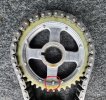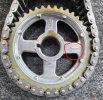Hi Team,
I have purchased a new cam kit from Wins International and have a couple of questions because the car still can like a pig after installing it. I have ended up pulling it all apart again (including the pistons which 3 off have broken top compression rings). Another order from the UK required.
1. The attached pics show the cam sprocket supplied. It has a "mark" on each side which could be the timing mark. Has anyone bought one of these and can tell me which is the right one to line up with the crank sprocket dot. I assume it is the one on the circumference as that lines up the same as the diagram in the manual.
2. What would be causing some of the new hydraulic lifters to be spongy. The odd bank are all nice and solid, but 6 of the even bank are spongy. I have taken the oil pump apart and it looks to be in fine nick. Oil pressure did seem to be low sitting at about 20psi when warm at idle.
Thanking you.
I have purchased a new cam kit from Wins International and have a couple of questions because the car still can like a pig after installing it. I have ended up pulling it all apart again (including the pistons which 3 off have broken top compression rings). Another order from the UK required.
1. The attached pics show the cam sprocket supplied. It has a "mark" on each side which could be the timing mark. Has anyone bought one of these and can tell me which is the right one to line up with the crank sprocket dot. I assume it is the one on the circumference as that lines up the same as the diagram in the manual.
2. What would be causing some of the new hydraulic lifters to be spongy. The odd bank are all nice and solid, but 6 of the even bank are spongy. I have taken the oil pump apart and it looks to be in fine nick. Oil pressure did seem to be low sitting at about 20psi when warm at idle.
Thanking you.





